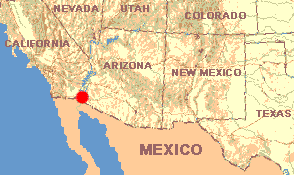 March 14, 1988
March 14, 1988CALIFORNIA: Imperial County; Imperial Sand Dunes National Recreation Area just off I-8, fifteen miles west of Yuma.
 March 14, 1988
March 14, 1988Zzeep!
High-pitched like the alarm signal of a small digital watch, the zzeeping sound seems to be coming from my own shirt pocket.
Zzeep!
I look all around inside Henry but of course I carry nothing that zzeeps. The sound must be ventriloqual and it must be coming from outside. Just as I figure this out and look outside, my mystery-zzeeper zips from beneath one Creosote-bush to another. It's the most nondescript, grayish ground squirrel imaginable, one called the Roundtail Ground Squirrel, Citellus tereticaudus. The field guide says that its species occurs from southern Nevada through southeastern California and southwestern Arizona into northwestern Mexico.
It's a scrawny-looking little animal with a body only six inches long and a tail only half that length. Its tail isn't bushy and it's not carried curled over the back. It's like a pencil very meagerly invested with short fur. The funny thing is that every time the roundtail zzeeps, the tail flies straight up.
This little mammal's drabness cannot be overstated. Gray with a pinkish cast, it bears no spots, no chipmunk-like stripes, or any other distinguishing feature, other than its unmistakable ground-squirrel form. Apparently Zzeeper makes its home inside the two-foot high mound of sand beneath the Creosote-bush beside Henry. Creosote-bushes usually are profusely branched from their bases so they make natural sand-grain catchers and sand-dune starters. Animals digging dens in these mounds benefit not only from the bush's shade, but also from its subterranean network of stems and roots, which keep the tunnels from collapsing.
On the ground beneath the Creosote bush, Zzeeper lies flat on his belly, with his front paws extended out front and his back legs similarly disposed behind, his straight tail continuing to pump upward with every zzeep. Eventually a second roundtail emerges from inside the Creosote-bush's shadows and takes up a stretched-out position not far from Zzeeper. This seems to irk Zzeeper, so he shoots to the Creosote-bush's other side and sprawls out as before. The second roundtail now goes to where Zzeeper had lain, seems to take great pleasure in sniffing the sand where Zzeeper's rear end had touched, and then returns to the shadows where he rubs the corner of his mouth on a Creosote-bush stem.
From this behavior I infer that the two animals probably are sexually active. With binoculars I look more closely at Zzeeper and sure enough he possesses testicles swelled all out of proportion to what a little mammal such as he would seem to need. When I look at the second roundtail I see... the same thing! I hadn't expected them both to be males.
From time to time one darts across the sand to quickly visit another Creosote bush, but soon he returns. Eventually Zzeeper quits zzeeping. I wish I could figure out what is going on here. The Peterson field guide states that this species' young are born in April, so it makes a good story for pregnant females right now to be at home in chambers below the bush while the males stand watch above. However, that's only conjecture.
During the afternoon one moment stands out as being exceptionally fine aesthetically. Zzeeper climbs onto a Creosote-bush's lower branch, reaches out with his paws, brings a flowering branch close, and eats the yellow blossoms. What a picture it made, seeing this small creature suspended among yellow blossoms and green-leaved limbs, with tiny paws earnestly manipulating the flowers being eaten.
Eyes of the roundtail are dark and large, as are any ground-squirrel's, so this gives the anthropomorphic person the impression that the animal is more wise and sensitive than perhaps it is.